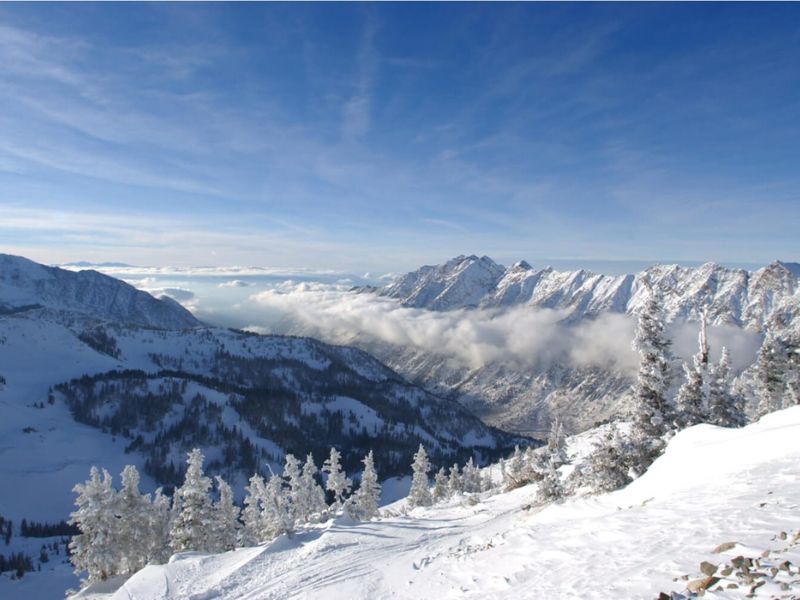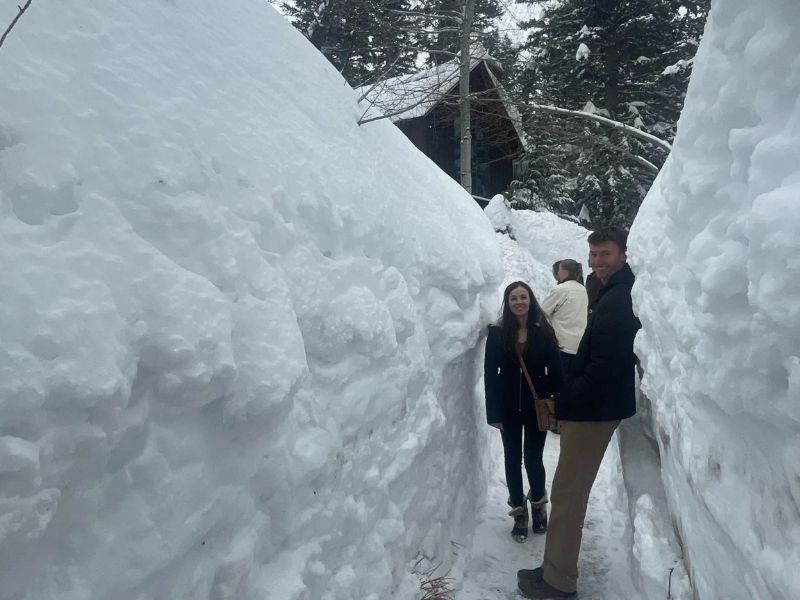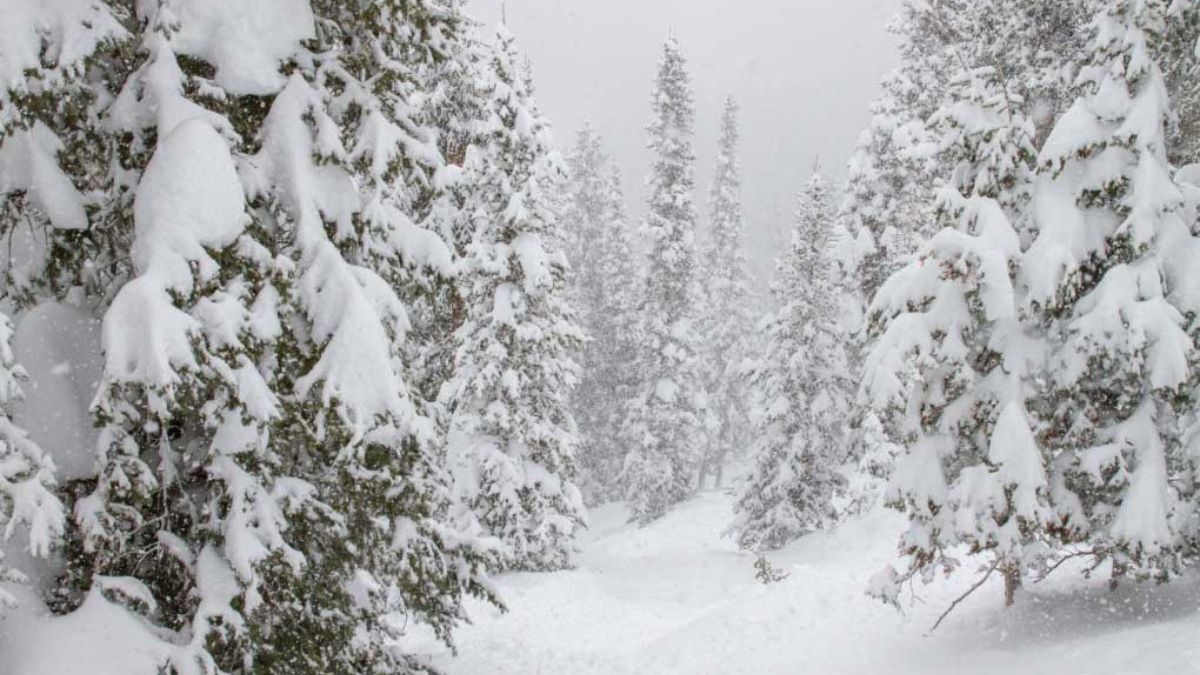Yes, it does snow in Utah. Utah is known for its abundant snowfall during the winter months, especially in the mountainous regions. The state’s climate is classified as semi-arid, but the presence of the Wasatch and Uinta mountain ranges, as well as the proximity to the Great Salt Lake, contributes to heavy snowfall in certain areas.
The snow season in Utah typically begins in November and lasts until March, with peak snowfall occurring in December and January. Utah’s reputation for having some of the best snow conditions for skiing and snowboarding has led to the slogan “The Greatest Snow on Earth.”
Utah, with its diverse landscapes and breathtaking scenery, is a popular destination for nature enthusiasts and adventure seekers throughout the year. However, one of the most remarkable and enchanting times to visit the Beehive State is during the winter months when a white blanket of snow transforms the landscape into a magical wonderland.
In this article, we delve into the snowfall patterns in Utah, the best places to experience a winter wonderland, and the various winter activities that draw visitors from all around the world.
Location Overview of Utah
Utah, often referred to as the Beehive State, is a landlocked state located in the western United States. It is known for its stunning and diverse landscapes, ranging from majestic mountains to red rock deserts, making it a paradise for nature enthusiasts and adventure seekers.
Utah is situated in the western part of the United States, bordered by Idaho and Wyoming to the north, Colorado to the east, Arizona to the south, and Nevada to the west. It covers an area of approximately 84,899 square miles and is the 13th largest state in the U.S.
The state’s geography is dominated by numerous mountain ranges and plateaus. The most prominent are the Wasatch Range, which runs north-south along the eastern edge of the state, and the Uinta Mountains, which are located in the northeastern region.
Utah is home to the Great Salt Lake, the largest saltwater lake in the Western Hemisphere. Located in the northern part of the state, it covers an area of approximately 1,700 square miles. The lake is a remnant of the prehistoric Lake Bonneville and is known for its high salinity.
Southern Utah is famous for its stunning red rock desert landscapes and several iconic national parks, including Zion National Park, Bryce Canyon National Park, Arches National Park, Canyonlands National Park, and Capitol Reef National Park.
These parks attract millions of visitors each year who come to explore the dramatic rock formations, slot canyons, and other natural wonders.
Major cities in Utah include:
- Salt Lake City: The capital and largest city of Utah, known for its outdoor recreational opportunities and cultural attractions.
- Provo: A university town, home to Brigham Young University (BYU), with a youthful and vibrant atmosphere.
- Ogden: Located in northern Utah, it offers access to numerous ski resorts and outdoor activities.
- St. George: A city in southern Utah, known for its warm climate and proximity to several national parks.
Utah’s location and geography offer a diverse and captivating experience for visitors and residents alike. From snow-capped mountains and world-class ski resorts to stunning red rock deserts and iconic national parks, the state’s natural beauty and recreational opportunities make it an exceptional destination for those seeking adventure.
Geography and Climate of Utah
Utah’s climate varies considerably based on its diverse geography. In the northern regions, including Salt Lake City, the climate is characterized by hot summers and cold winters with significant snowfall, especially in the mountainous areas.
Southern Utah experiences a more arid climate, with hot summers and mild winters. The state is known for its dry air and sunny days, making it an attractive destination for outdoor activities year-round. The state is known for its dry air and sunny days, making it a popular destination for outdoor activities year-round.
Historical Snowfall Record of Utah
Utah has a reputation for receiving abundant snowfall during the winter months, particularly in the mountainous regions. The snow season typically starts in November and lasts until March, with peak snowfall occurring in December and January.

The historical snowfall records in Utah vary from year to year, and different regions within the state can experience different amounts of snowfall due to various weather patterns. The Wasatch Range, including popular ski destinations like Park City, often receives substantial snowfall due to its proximity to the Great Salt Lake.
Here are some prominent past snow events in Utah:
- Winter of 1992-1993
This winter season was particularly memorable in Utah due to its record-breaking snowfall. Several locations across the state received significant snow accumulation, with some areas reporting over 700 inches of total snowfall during the season.
- December 2010
Utah experienced a series of heavy snowstorms in December 2010, leading to widespread snowfall and challenging travel conditions. This snow event impacted various ski resorts positively, creating excellent skiing and snowboarding conditions.
Winter Season & Snowfall Pattern of Utah
Utah is renowned for its ample snowfall, making it a paradise for winter enthusiasts. The state’s climate is classified as semi-arid, but due to its mountainous terrain and proximity to the Great Salt Lake, the Wasatch and Uinta mountain ranges often experience heavy snowfall during winter.
The phenomenon known as the “lake-effect snow” plays a significant role in enhancing snowfall in certain areas. As cold air passes over the Great Salt Lake, it picks up moisture, which then falls as snow on the eastern side of the lake and the adjacent mountains.
This unique weather pattern results in the famous “Greatest Snow on Earth,” a term often used to describe the exceptional quality of Utah’s powder snow.
Locations to Enjoy Snow in Utah
Utah offers numerous locations where you can enjoy the snow during the winter season. Whether you’re into skiing, snowboarding, snowshoeing, or simply want to experience the winter wonderland, here are some popular destinations to enjoy snow in Utah:

- Park City
One of Utah’s most famous winter destinations, Park City is home to world-class ski resorts such as Park City Mountain Resort and Deer Valley Resort. Aside from skiing and snowboarding, the town itself has a charming ambiance with great dining, shopping, and après-ski activities.
- Salt Lake City
Utah’s capital city provides convenient access to multiple ski resorts, making it an excellent base for winter enthusiasts. Resorts like Snowbird, Alta, Brighton, and Solitude are within a short drive from Salt Lake City.
- Ogden Valley
Located in the Wasatch Mountains, Ogden Valley offers a quieter and more secluded winter experience. Snowbasin Resort and Powder Mountain are popular destinations for skiing and snowboarding in this area.
- Sundance Mountain Resort
Nestled in the Provo Canyon, Sundance offers a picturesque setting for winter activities. The resort caters to skiers, snowboarders, and snowshoers, and its emphasis on environmental preservation adds to its appeal.
- Brian Head
Located in southern Utah, Brian Head is a great destination for skiing and snowboarding with a more relaxed and laid-back atmosphere compared to the larger resorts up north.
- Moab
While known for its red rock landscapes, winter in Moab offers a unique experience. Visit Arches National Park and Canyonlands National Park with fewer crowds, and enjoy stunning snow-capped vistas in the desert.
- Logan Canyon
If you prefer a scenic winter drive and opportunities for snowshoeing or cross-country skiing, Logan Canyon in northern Utah offers beautiful winter landscapes and outdoor adventures.
- Bear Lake
Known as the “Caribbean of the Rockies” in the summer, Bear Lake becomes a winter wonderland with opportunities for ice fishing, snowmobiling, and even ice-skating when conditions permit.
- Cedar City
This city in southern Utah is a gateway to Brian Head and offers a mix of winter activities along with cultural experiences and proximity to beautiful national parks.
Whether you are an experienced winter sports enthusiast or just looking to enjoy the snowy landscapes, Utah has a wealth of options for everyone to embrace the winter season.
Factors Influencing Snowfall in Utah
Several factors influence snowfall patterns in Utah. The most significant factor is the state’s geography, characterized by the Wasatch and Uinta mountain ranges. These mountains act as barriers, causing moist air masses from the Pacific to rise and cool, resulting in snowfall.
Additionally, Utah’s proximity to the Great Salt Lake plays a crucial role in the occurrence of “lake-effect snow.” Cold air passing over the lake picks up moisture, leading to enhanced snowfall in the eastern regions of the state.
The elevation also plays a role, as higher elevations receive more snow than lower areas. Overall, Utah’s unique geography and climatic conditions contribute to the ample snowfall that makes it a renowned winter destination.
Conclusion
Utah is undoubtedly a winter wonderland, with its abundant and high-quality snowfall attracting winter sports enthusiasts and nature lovers from all walks of life. From skiing and snowboarding to exploring the serene beauty of snow-capped landscapes, the Beehive State offers a plethora of winter activities for everyone to enjoy.
So, whether you seek thrilling adventures or peaceful moments in nature, Utah’s snowy embrace is sure to leave you with lasting memories and a yearning to return.
